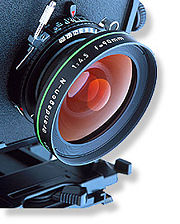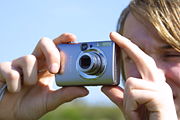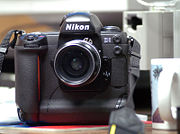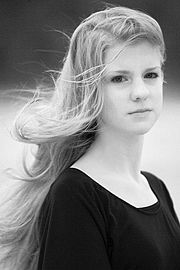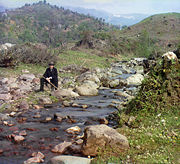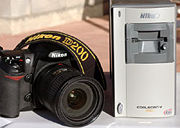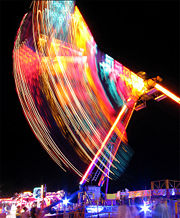Photography
2008/9 Schools Wikipedia Selection. Related subjects: Art; Recreation
Photography (IPA: [fә'tɒgrәfi] or IPA: [fә'tɑːgrәfi]) is the process and art of recording pictures by means of capturing light on a light-sensitive medium, such as a film or electronic sensor. Light patterns reflected or emitted from objects expose a sensitive silver halide based chemical or electronic medium during a timed exposure, usually through a photographic lens in a device known as a camera that also stores the resulting information chemically or electronically. Photography has many uses for both business and pleasure. It is often the basis of advertising and in fashion print. Photography can also be viewed as a commercial and artistic endeavor.
The word "photography" comes from the French photographie which is based on the Greek φώς (phos) "light" + γραφίς (graphis) "stylus", "paintbrush" or γραφή (graphê) "representation by means of lines" or "drawing", together meaning "drawing with light." Traditionally, the product of photography has been called a photograph, commonly shortened to photo.
Photographic cameras
The camera or camera obscura is the image-forming device, and photographic film or a silicon electronic image sensor is the sensing medium. The respective recording medium can be the film itself, or a digital electronic or magnetic memory.
Photographers control the camera and lens to "expose" the light recording material (such as film) to the required amount of light to form a " latent image" (on film) or "raw file" (in digital cameras) which, after appropriate processing, is converted to a usable image. Digital cameras replace film with an electronic image sensor based on light-sensitive electronics such as charge-coupled device (CCD) or complementary metal-oxide-semiconductor (CMOS) technology. The resulting digital image is stored electronically, but can be reproduced on paper or film.
In all but certain specialized cameras, the process of obtaining a usable exposure must involve the use, manually or automatically, of a few controls to ensure the photograph is clear, sharp and well illuminated. The controls usually include but are not limited to the following:
- Focus of the lens
- Aperture of the lens – adjustment of the iris, measured as f-number, which controls the amount of light passing through the lens. Aperture also has an effect on focus and depth of field, namely, the smaller the opening [aperture], the less light but the greater the depth of field--that is, the greater the range within which objects appear to be sharply focused.
- Shutter speed – adjustment of the speed (often expressed either as fractions of seconds or as an angle, with mechanical shutters) of the shutter to control the amount of time during which the imaging medium is exposed to light for each exposure. Shutter speed may be used to control the amount of light striking the image plane; 'faster' shutter speeds (that is, those of shorter duration) decrease both the amount of light and the amount of image blurring from subject motion or camera motion.
- White balance – on digital cameras, electronic compensation for the colour temperature associated with a given set of lighting conditions, ensuring that white light is registered as such on the imaging chip and therefore that the colors in the frame will appear natural. On mechanical, film-based cameras, this function is served by the operator's choice of film stock. In addition to using white balance to register natural coloration of the image, photographers may employ white balance to aesthetic end, for example white balancing to a blue object in order to obtain a warm colour temperature.
- Metering – measurement of exposure at a midtone so that highlights and shadows are exposed according to the photographer's wishes. Many modern cameras feature this ability, though it is traditionally accomplished with the use of a separate light metering device. To translate the amount of light into a usable aperture and shutter speed, the meter needs to input the sensitivity of the film or sensor to light. Thus there needs to be a setting for "film speed" or ISO sensitivity.
- ISO speed – traditionally used to "tell the camera" the film speed of the selected film on film cameras, ISO speeds are employed on modern digital cameras as an indication of the system's gain from light to numerical output and to control the automatic exposure system. A correct combination of ISO speed, aperture, and shutter speed leads to an image that is neither too dark nor too light.
- Auto-focus point – on some cameras, the selection of a point in the imaging frame upon which the auto-focus system will attempt to focus. Many Single-lens reflex cameras (SLR) feature multiple auto-focus points in the viewfinder.
Many other elements of the imaging device itself may have a pronounced effect on the quality and/or aesthetic effect of a given photograph; among them are:
- Focal length and type of lens ( telephoto or "long" lens, macro, wide angle, fisheye, or zoom)
- Filters or scrims placed between the subject and the light recording material, either in front of or behind the lens
- Inherent sensitivity of the medium to light intensity and colour/wavelengths.
- The nature of the light recording material, for example its resolution as measured in pixels or grains of silver halide.
Controlling the photographic exposure and rendering
Camera controls are inter-related. The total amount of light reaching the film plane (the "exposure") changes with the duration of exposure, aperture of the lens, and, the effective focal length of the lens (which in variable focal length lenses, can change as the lens is zoomed). Changing any of these controls can alter the exposure. Many cameras may be set to adjust most or all of these controls automatically. This automatic functionality is useful for occasional photographers in many situations.
The duration of an exposure is referred to as shutter speed, often even in cameras that don't have a physical shutter, and is typically measured in fractions of a second. Aperture is expressed by an f-number or f-stop (derived from focal ratio), which is proportional to the ratio of the focal length to the diameter of the aperture. If the f-number is decreased by a factor of  , the aperture diameter is increased by the same factor, and its area is increased by a factor of 2. The f-stops that might be found on a typical lens include 2.8, 4, 5.6, 8, 11, 16, 22, 32, where going up "one stop" (using lower f-stop numbers) doubles the amount of light reaching the film, and stopping down one stop halves the amount of light.
, the aperture diameter is increased by the same factor, and its area is increased by a factor of 2. The f-stops that might be found on a typical lens include 2.8, 4, 5.6, 8, 11, 16, 22, 32, where going up "one stop" (using lower f-stop numbers) doubles the amount of light reaching the film, and stopping down one stop halves the amount of light.
Exposures can be achieved through various combinations of shutter speed and aperture. For example, f/8 at 8 ms (=1/125th of a second) and f/5.6 at 4 ms (=1/250th of a second) yield the same amount of light. The chosen combination has an impact on the final result. In addition to the subject or camera movement that might vary depending on the shutter speed, the aperture (and focal length of the lens) determine the depth of field, which refers to the range of distances from the lens that will be in focus. For example, using a long lens and a large aperture (f/2.8, for example), a subject's eyes might be in sharp focus, but not the tip of the nose. With a smaller aperture (f/22), or a shorter lens, both the subject's eyes and nose can be in focus. With very small apertures, such as pinholes, a wide range of distance can be brought into focus.
Image capture is only part of the image forming process. Regardless of material, some process must be employed to render the latent image captured by the camera into the final photographic work. This process consists of two steps, development, and printing.
During the printing process, modifications can be made to the print by several controls. Many of these controls are similar to controls during image capture, while some are exclusive to the printing process. Most controls have equivalent digital concepts, but some create different effects. For example, dodging and burning controls are different between digital and film processes. Other printing modifications include:
- Chemicals and process used during film development
- Duration of exposure – equivalent to shutter speed
- Printing aperture – equivalent to aperture, but has no effect on depth of field
- Contrast
- Dodging – reduces exposure of certain print areas, resulting in lighter areas
- Burning – increases exposure of certain areas, resulting in darker areas
- Paper texture – glossy, matte, etc
- Paper type – resin-coated (RC) or fibre-based (FB)
- Paper size
- Toners – used to add warm to cool tones to black and white
Uses of photography
Photography gained the interest of many scientists and artists from its inception. Scientists have used photography to record and study movements, such as Eadweard Muybridge's study of human and animal locomotion in 1887. Artists are equally interested by these aspects but also try to explore avenues other than the photo-mechanical representation of reality, such as the pictorialist movement. Military, police, and security forces use photography for surveillance, recognition and data storage. Photography is used to preserve memories of favorite times, to capture special moments, to tell stories, to send messages, and as a source of entertainment.
Commercial advertising relies heavily on photography and has contributed greatly to its development.
History of photography
Photography is the result of combining several technical discoveries. Long before the first photographs were made, Ibn al-Haytham (Alhazen) (965–1040) invented the camera obscura and pinhole camera, Albertus Magnus (1193–1280) discovered silver nitrate, and Georges Fabricius (1516–1571) discovered silver chloride. Daniel Barbaro described a diaphragm in 1568. Wilhelm Homberg described how light darkened some chemicals (photochemical effect) in 1694. The fiction book Giphantie, by French author Tiphaigne de la Roche, described what can be interpreted as photography.
Photography as a usable process goes back to the 1820s with the development of chemical photography. The first permanent photograph was an image produced in 1826 by the French inventor Nicéphore Niépce. However, the picture took eight hours to expose, so he went about trying to find a new process. Working in conjunction with Louis Daguerre, they experimented with silver compounds based on a Johann Heinrich Schultz discovery in 1724 that a silver and chalk mixture darkens when exposed to light. Niépce died in 1833, but Daguerre continued the work, eventually culminating with the development of the daguerreotype in 1837. Eventually, France agreed to pay Daguerre a pension for his formula, in exchange for his promise to announce his discovery to the world as the gift of France, which he did in 1839.
Meanwhile, Hercules Florence had already created a very similar process in 1832, naming it Photographie, and William Fox Talbot had earlier discovered another means to fix a silver process image but had kept it secret. After reading about Daguerre's invention, Talbot refined his process so that it might be fast enough to take photographs of people. By 1840, Talbot had invented the calotype process, which creates negative images. John Herschel made many contributions to the new methods. He invented the cyanotype process, now familiar as the "blueprint". He was the first to use the terms "photography", "negative" and "positive". He discovered sodium thiosulphate solution to be a solvent of silver halides in 1819, and informed Talbot and Daguerre of his discovery in 1839 that it could be used to "fix" pictures and make them permanent. He made the first glass negative in late 1839.
In March of 1851, Frederick Scott Archer published his findings in "The Chemist" on the wet plate collodion process. This became the most widely used process between 1852 and the late 1880s when the dry plate was introduced. There are three subsets to the Collodion process; the Ambrotype (positive image on glass), the Ferrotype or Tintype (positive image on metal) and the negative which was printed on Albumen or Salt paper.
Many advances in photographic glass plates and printing were made in through the nineteenth century. In 1884, George Eastman developed the technology of film to replace photographic plates, leading to the technology used by film cameras today.
In 1908 Gabriel Lippmann won the Nobel Laureate in Physics for his method of reproducing colours photographically based on the phenomenon of interference, also known as the Lippmann plate.
Photography types
Black-and-white photography
All photography was originally monochrome, most of these photographs were black-and-white. Even after colour film was readily available, black-and-white photography continued to dominate for decades, due to its lower cost and its "classic" photographic look. It is important to note that some monochromatic pictures are not always pure blacks and whites, but also contain other hues depending on the process. The Cyanotype process produces an image of blue and white for example. The albumen process which was used more then 150 years ago had brown tones.
Many photographers continue to produce some monochrome images. Some full colour digital images are processed using a variety of techniques to create black and whites, and some cameras have even been produced to exclusively shoot monochrome.
Colour photography
Colour photography was explored beginning in the mid 1800s. Early experiments in color could not fix the photograph and prevent the color from fading. The first permanent colour photo was taken in 1861 by the physicist James Clerk Maxwell.
One of the early methods of taking color photos was to use three cameras. Each camera would have a colour filter in front of the lens. This technique provides the photographer with the three basic channels required to recreate a colour image in a darkroom or processing plant. Russian photographer Sergei Mikhailovich Prokudin-Gorskii developed another technique, with three colour plates taken in quick succession.
Practical application of the technique was held back by the very limited colour response of early film; however, in the early 1900s, following the work of photo-chemists such as H. W. Vogel, emulsions with adequate sensitivity to green and red light at last became available.
The first colour plate, Autochrome, invented by the French Lumière brothers, reached the market in 1907. It was based on a 'screen-plate' filter made of dyed dots of potato starch, and was the only colour film on the market until German Agfa introduced the similar Agfacolor in 1932. In 1935, American Kodak introduced the first modern ('integrated tri-pack') colour film, Kodachrome, based on three colored emulsions. This was followed in 1936 by Agfa's Agfacolor Neue. Unlike the Kodachrome tri-pack process, the color couplers in Agfacolor Neue were integral with the emulsion layers, which greatly simplified the film processing. Most modern colour films, except Kodachrome, are based on the Agfacolor Neue technology. Instant colour film was introduced by Polaroid in 1963.
Colour photography may form images as a positive transparency, intended for use in a slide projector or as color negatives, intended for use in creating positive color enlargements on specially coated paper. The latter is now the most common form of film (non-digital) colour photography owing to the introduction of automated photoprinting equipment.
Full-spectrum, ultraviolet and infrared photography
Ultraviolet and infrared films have been available for many decades and employed in a variety of photographic avenues since the 1960s. New technological trends in digital photography have opened a new direction in full spectrum photography, where careful filtering choices across the ultraviolet, visible and infrared lead to new artistic visions.
Modified digital cameras can detect some ultraviolet, all of the visible and much of the near infrared spectrum, as most digital imaging sensors are sensitive from about 350nm to 1000nm. An off-the-shelf digital camera contains an infrared hot mirror filter that blocks most of the infrared and a bit of the ultraviolet that would otherwise be detected by the sensor, narrowing the accepted range from about 400nm to 700nm. Replacing a hot mirror or infrared blocking filter with an infrared pass or a wide spectrally transmitting filter allows the camera to detect the wider spectrum light at greater sensitivity. Without the hot-mirror, the red, green and blue (or cyan, yellow and magenta) colored micro-filters placed over the sensor elements pass varying amounts of ultraviolet (blue window) and infrared (primarily red, and somewhat lesser the green and blue micro-filters).
Uses of full spectrum photography are for fine art photography, geology, forensics & law enforcement, and even some claimed use in ghost hunting.
Digital photography
Traditional photography burdened photographers working at remote locations without easy access to processing facilities, and competition from television pressured photographers to deliver images to newspapers with greater speed. Photo journalists at remote locations often carried miniature photo labs and a means of transmitting images through telephone lines. In 1981, Sony unveiled the first consumer camera to use a charge-coupled device for imaging, eliminating the need for film: the Sony Mavica. While the Mavica saved images to disk, the images were displayed on television, and the camera was not fully digital. In 1990, Kodak unveiled the DCS 100, the first commercially available digital camera. Although its high cost precluded uses other than photojournalism and professional photography, commercial digital photography was born.
Digital imaging uses an electronic image sensor to record the image as a set of electronic data rather than as chemical changes on film. The primary difference between digital and chemical photography is that chemical photography resists manipulation because it involves film and photographic paper, while digital imaging is a highly manipulative medium. This difference allows for a degree of image post-processing that is comparatively difficult in film-based photography and permits different communicative potentials and applications.
Digital point-and-shoot cameras have become widespread consumer products, outselling film cameras, and including new features such as video and audio recording. Kodak announced in January 2004 that it would no longer sell reloadable 35 mm cameras in western Europe, Canada and the United States after the end of that year. Kodak was at that time a minor player in the reloadable film cameras market. In January 2006, Nikon followed suit and announced that they will stop the production of all but two models of their film cameras: the low-end Nikon FM10, and the high-end Nikon F6. On May 25, 2006, Canon announced they will stop developing new film SLR cameras.
According to a survey made by Kodak in 2007, 75 percent of professional photographers say they will continue to use film, even though some embrace digital.
According to the U.S. survey results, more than two-thirds (68 percent) of professional photographers prefer the results of film to those of digital for certain applications including:
- film’s superiority in capturing more information on medium and large format films (48 percent);
- creating a traditional photographic look (48 percent);
- capturing shadow and highlighting details (45 percent);
- the wide exposure latitude of film (42 percent); and
- archival storage (38 percent)
Because photography is popularly synonymous with truth ("The camera doesn't lie."), digital imaging has raised many ethical concerns. Many photojournalists have declared they will not crop their pictures, or are forbidden from combining elements of multiple photos to make "illustrations," passing them as real photographs. Many courts will not accept digital images as evidence because of their inherently manipulative nature. Today's technology has made picture editing relatively simple for even the novice photographer.
Recent changes of in-camera processing allows digital fingerprinting of RAW photos to verify against tampering of digital photos for forensics use.
Photography styles
Commercial photography
Commercial photography is probably best defined as any photography to which money exchanges hands. In this light money could be paid for the subject of the photograph or the photograph itself. Wholesale, retail, and professional uses of photography would fall under this definition. The commercial photographic world could include:
- Advertising photography: photographs made to illustrate and usually sell a service or product. These images are generally done with an advertising agency, design firm or with an in-house corporate design team.
- Fashion and glamour photography: This type of photography usually incorporates models. Fashion photography emphasizes the clothes or product, glamour emphasizes the model. Glamour photography is popular in advertising and in men's magazines. Models in glamour photography may be nude, but this is not always the case.
- Crime Scene Photography: This type of photography consists of photographing scenes of crime such as robberies and murders. A black and white camera or an infrared camera may be used to capture specific details.
- Still life photography usually depicts inanimate subject matter, typically commonplace objects which may be either natural or man-made.
- Food photography can be used for editorial, packaging or advertising use. Food photography is similar to still life photography, but requires some special skills.
- Editorial photography: photographs made to illustrate a story or idea within the context of a magazine. These are usually assigned by the magazine.
- Photojournalism: this can be considered a subset of editorial photography. Photographs made in this context are accepted as a documentation of a news story.
- Portrait and wedding photography: photographs made and sold directly to the end user of the images.
- Fine art photography: photographs made to fulfill a vision, and reproduced to be sold directly to the customer.
- Landscape photography: photographs of different locations made to be sold to tourists as postcards
- Conceptual photography: Photography that turns a concept or idea into a photograph. Even though what is depicted in the photographs are real objects, the subject is strictly abstract.
- Wildlife photography that demonstrates life of the animals.
- Pornography: explicit depiction of sexual subject matter, especially with the sole intention of sexually exciting the viewer using a variety of media including photography. See History of erotic photography.
- Photo sharing: publishing or transfer of a user's digital photos online.
The market for photographic services demonstrates the aphorism "one picture is worth a thousand words," which has an interesting basis in the history of photography. Magazines and newspapers, companies putting up Web sites, advertising agencies and other groups pay for photography.
Many people take photographs for self-fulfillment or for commercial purposes. Organizations with a budget and a need for photography have several options: they can employ a photographer directly, organize a public competition, or obtain rights to stock photographs. Photo stock can be procured through traditional stock giants, such as Getty Images or Corbis; smaller microstock agencies, such as Fotolia; or web marketplaces, such as Cutcaster.
Photography as an art form
During the twentieth century, both fine art photography and documentary photography became accepted by the English-speaking art world and the gallery system. In the United States, a handful of photographers, including Alfred Stieglitz, Edward Steichen, John Szarkowski, and Edward Weston, spent their lives advocating for photography as a fine art. At first, fine art photographers tried to imitate painting styles. This movement is called Pictorialism, often using soft focus for a dreamy, 'romantic' look. In reaction to that, Weston, Ansel Adams, and others formed the f/64 Group to advocate 'straight photography', the photograph as a (sharply focused) thing in itself and not an imitation of something else.
The aesthetics of photography is a matter that continues to be discussed regularly, especially in artistic circles. Many artists argued that photography was the mechanical reproduction of an image. If photography is authentically art, then photography in the context of art would need redefinition, such as determining what component of a photograph makes it beautiful to the viewer. The controversy began with the earliest images "written with light"; Nicéphore Niépce, Louis Daguerre, and others among the very earliest photographers were met with acclaim, but some questioned if their work met the definitions and purposes of art.
Clive Bell in his classic essay Art states that only "significant form" can distinguish art from what is not art.
| “ | There must be some one quality without which a work of art cannot exist; possessing which, in the least degree, no work is altogether worthless. What is this quality? What quality is shared by all objects that provoke our aesthetic emotions? What quality is common to Sta. Sophia and the windows at Chartres, Mexican sculpture, a Persian bowl, Chinese carpets, Giotto's frescoes at Padua, and the masterpieces of Poussin, Piero della Francesca, and Cezanne? Only one answer seems possible - significant form. In each, lines and colors combined in a particular way, certain forms and relations of forms, stir our aesthetic emotions. | ” |
On February 14th 2006 Sotheby’s London sold the 2001 photograph " 99 Cent II Diptychon" for an unprecedented $3,346,456 to an anonymous bidder making it the most expensive of all time.
Technical photography
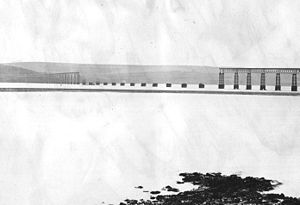
The camera has a long and distinguished history as a means of recording phenomena from the first use by Daguerre and Fox-Talbot, such as astronomical events (eclipses for example) and small creatures when the camera was attached to the eyepiece of microscopes (in photomicroscopy). The camera also proved useful in recording crime scenes and the scenes of accidents, one of the first uses being at the scene of the Tay Rail Bridge disaster of 1879. The set of accident photographs was used in the subsequent court of inquiry so that witnesses could identify pieces of the wreckage, and the technique is now commonplace in courts of law. The set of over 50 Tay bridge photographs are of very high quality and when scanned at high resolution, can be enlarged to show details of the failed components such as broken cast iron lugs and the tie bars which failed to hold the towers in place. They show that the bridge was badly designed, badly built and badly maintained.
Between 1846 and 1852 Charles Brooke invented a technology for the automatic registration of instruments by photography. These instruments included barometers, thermometers, psychrometers, and magnetometers, which recorded their readings by means of an automated photographic process.
Other photographic image forming techniques
Besides the camera, other methods of forming images with light are available. For instance, a photocopy or xerography machine forms permanent images but uses the transfer of static electrical charges rather than photographic film, hence the term electrophotography. Photograms are images produced by the shadows of objects cast on the photographic paper, without the use of a camera. Objects can also be placed directly on the glass of an image scanner to produce digital pictures.
